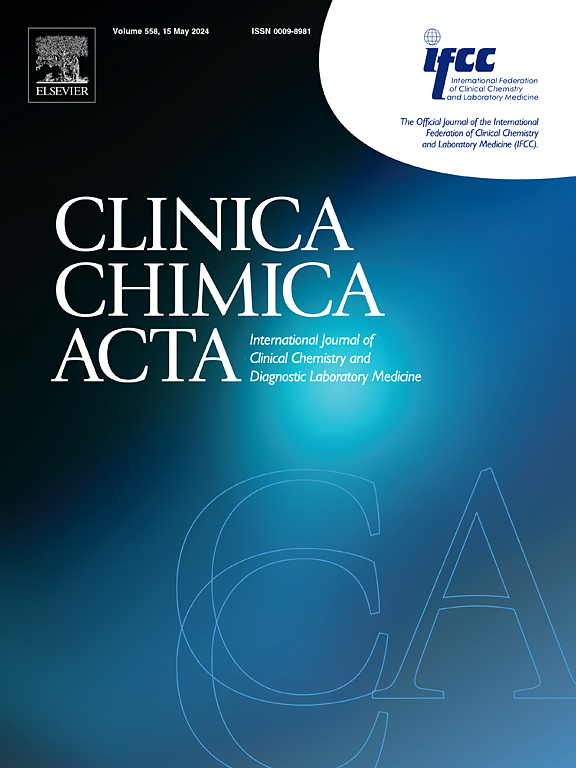作为肝细胞癌诊断标志物的六种血清 microRNAs 的组合模型。
IF 3.2
3区 医学
Q2 MEDICAL LABORATORY TECHNOLOGY
引用次数: 0
摘要
背景:肝细胞癌(HCC)与高发病率和高死亡率相关,其预后不良的主要原因是缺乏有效的早期诊断手段。本研究旨在确定一组血清微RNA(miRNA)作为诊断HCC的潜在生物标志物:我们收集了 190 例 HCC 病例、109 例肝脏良性病变、40 例非 HCC 肿瘤和 130 例健康对照。469名参与者被分为训练集和验证集。文献检索发现了 12 个与 HCC 密切相关的 miRNA。在训练集中,利用实时定量 PCR 筛选了明显差异表达的 miRNA(DEmiRNA),并利用逻辑回归分析构建了一个 HCC 诊断模型。利用验证集进行了独立验证。对鉴定出的 DE miRNA 进行了靶基因预测和功能分析:与对照组相比,miR-21、miR-221、miR-801 和 miR-1246 在 HCC 中的水平显著下降(P 结论:HCC 中的 miR-1246 和 miR-21 水平显著高于对照组(P):基于六种 DE miRNA 组合构建的诊断模型对早期诊断 HCC 具有重要的临床价值。本文章由计算机程序翻译,如有差异,请以英文原文为准。
A combined model of six serum microRNAs as diagnostic markers for hepatocellular carcinoma
Background
Hepatocellular carcinoma (HCC) is associated with high morbidity and mortality, and its poor prognosis is mainly due to the lack of an effective means of early diagnosis. This study aimed to identify a group of serum microRNAs (miRNAs) as potential biomarkers for the diagnosis of HCC.
Methods
We collected 190 HCC cases, 109 benign lesions of the liver, 40 cases of non-HCC tumors, and 130 healthy controls. The 469 participants were divided into training and validation sets. A literature search revealed 12 miRNAs closely associated with HCC. In the training set, significantly differentially expressed miRNAs (DEmiRNAs) were screened using real-time quantitative PCR, and a diagnostic model of HCC was constructed using logistic regression analysis. An independent validation was performed using a validation set. The identified DE miRNAs were subjected to target gene prediction and functional analyses.
Results
Compared to the controls, the levels of miR-21, miR-221, miR-801, and miR-1246 significantly decreased in HCC (P < 0.05), while the levels of miR-26a and miR-122 significantly increased (P < 0.05). A diagnostic model based on the six DE miRNAs was successfully constructed, with AUC values of 0.953 for the training set and 0.952 for the verification set. Finally, 100 target genes of the DE miRNAs were predicted and were significantly enriched in the B cell receptor, neurotrophin, ferroptosis, and EGFR tyrosine kinase inhibitor resistance signaling pathways.
Conclusions
The constructed diagnostic model based on six DE miRNA combinations has important clinical value for the early diagnosis of HCC.
求助全文
通过发布文献求助,成功后即可免费获取论文全文。
去求助
来源期刊

Clinica Chimica Acta
医学-医学实验技术
CiteScore
10.10
自引率
2.00%
发文量
1268
审稿时长
23 days
期刊介绍:
The Official Journal of the International Federation of Clinical Chemistry and Laboratory Medicine (IFCC)
Clinica Chimica Acta is a high-quality journal which publishes original Research Communications in the field of clinical chemistry and laboratory medicine, defined as the diagnostic application of chemistry, biochemistry, immunochemistry, biochemical aspects of hematology, toxicology, and molecular biology to the study of human disease in body fluids and cells.
The objective of the journal is to publish novel information leading to a better understanding of biological mechanisms of human diseases, their prevention, diagnosis, and patient management. Reports of an applied clinical character are also welcome. Papers concerned with normal metabolic processes or with constituents of normal cells or body fluids, such as reports of experimental or clinical studies in animals, are only considered when they are clearly and directly relevant to human disease. Evaluation of commercial products have a low priority for publication, unless they are novel or represent a technological breakthrough. Studies dealing with effects of drugs and natural products and studies dealing with the redox status in various diseases are not within the journal''s scope. Development and evaluation of novel analytical methodologies where applicable to diagnostic clinical chemistry and laboratory medicine, including point-of-care testing, and topics on laboratory management and informatics will also be considered. Studies focused on emerging diagnostic technologies and (big) data analysis procedures including digitalization, mobile Health, and artificial Intelligence applied to Laboratory Medicine are also of interest.
 求助内容:
求助内容: 应助结果提醒方式:
应助结果提醒方式:


